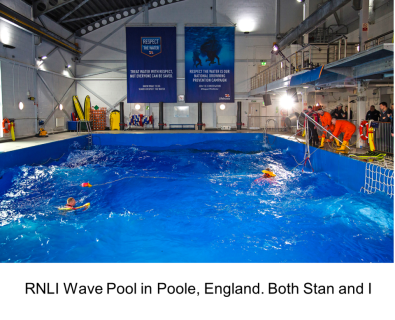What Makes One Life Jacket Better Than Another?
“Safety Moments, presented at CCA Stations and Posts”
By Chuck Hawley, San Francisco Station
How would you go about figuring out if a life jacket design is capable of saving a life when used in rough water? What would you look for? How would you measure the life jacket’s effectiveness? Which models would you accept, and which ones would you fail?
This is the challenge faced by standards writers like the Standards Technical Panel (STP) members at Underwriter’s Laboratories (UL). They are charged with coming up with standards for products like life jackets that, when met by the product’s design and materials and manufacturing consistency, have a reasonable expectation of working as intended. This doesn’t mean that the products work perfectly, but rather that they meet the standard’s target for performance, i.e. saving the lives of people in water, in this instance.
For a life jacket to be effective in saving someone’s life, there is a chain of events that must occur:
- It has to be available to the wearer.
- Presuming it’s available, it has to be completely donned.
- After donning, it has to be completely reliable.
- Finally, it has to be effective.
Ah, it has to be effective. But what makes a life jacket effective? The objective of a life jacket is to keep the wearer (person in water, or PIW) alive long enough to be rescued or to self-rescue. Even the best life jacket design imaginable will be ineffective if the wearer is never rescued, so there’s the added issue of being detectable, even if the life jacket keeps you alive for an extended period of time.
How does a life jacket keep the wearer from drowning? Engineers and physiologists talk of maintaining an airway and/or avoiding mouth immersions. When PIWs begin to aspirate water, due to poorly timed breaths when their mouths are underwater, the drowning process begins. Keeping the PIW’s mouth above the water is vital to prevent drowning (which is true whether the PIW is conscious or unconscious.)
So what aspects of a life jacket’s performance offer the best predictability of avoiding mouth immersions? The authors of a paper on the subject, Risk Models for Evaluation and Type Classification of Personal Flotation Devices[1] looked at several parameters related to life jacket performance:
- Freeboard: the distance between the surface of the water and the mouth
- Heave period: the time that a person remains immersed when forced underwater in calm conditions
- Turning time and ability: the time necessary to turn a face-down wearer to an attitude when his respiration is not impeded
- Face plane angle: the angle made by a line connecting the chin to the forehead to the surface of the water
- Placement security: the tendency for the life jacket to stay in place and not ride up on the torso of the wearer
Each of these parameters has a range of acceptable performance, as well as a point at which the life jacket fails the test and is rejected. For example, if a life jacket does not provide freeboard to the wearer, it is rejected. A life jacket that slips off the wearer is rejected. And a life jacket which leaves a wearer submerged for too long after a wave passes by is rejected.
This last parameter, the heave period, is especially predictive when it comes to mouth immersions. As one can imagine, the longer the wearer is immersed after a wave passes by him, the greater the chance s/he has of trying to breathe while her/his mouth is immersed, leading to aspirating water.
Heave period is a measured parameter, and not something that’s immediately obvious by examining a life jacket, but it’s related to the amount of buoyancy that’s not immersed in a static floating condition. In other words, the amount of the life jacket that is “in the air” (above the waterplane) in calm conditions is a reasonable predictor of how quickly a submerged individual will return to the surface. Life jackets that provide adequate freeboard in calm conditions but which are entirely submerged e.g. a ski-belt, don’t provide “reserve buoyancy” when the wearer is further immersed. Contrarily, life jackets that may appear to have a high percentage of their buoyant material above the waterplane in calm conditions will increase their buoyant force as they are forced into the water, and force the wearer back to the surface more quickly.
This is one of the main reasons that sailors who anticipate a possible man-overboard situation in rough waters need to wear high buoyancy life jackets. While other types of life jackets may provide freeboard and other measurements of life saving potential, high buoyancy is highly associated with a short heave period, resulting in less time spent with one’s mouth underwater.
The Cruising Club of America is a collection of passionate, seriously accomplished, ocean sailors making adventurous use of the seas. All members have extensive offshore boat handling, seamanship, and command experience honed over many years. “School of Hard Rocks” stories, published by the CCA Safety and Seamanship Committee, are intended to advance seamanship and help skippers promote a Culture of Safety aboard their vessels
[1] Bilal M Ayyub, Samuel Wehr, published in the ASCE-ASME Journal of Risk and Uncertainty in Engineering Systems, March 2015





